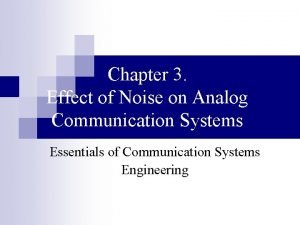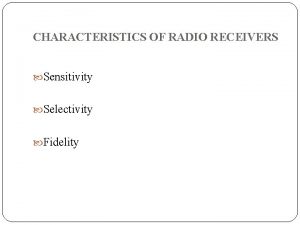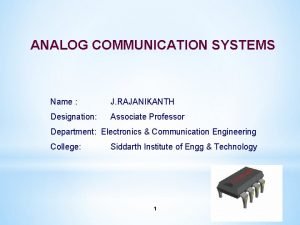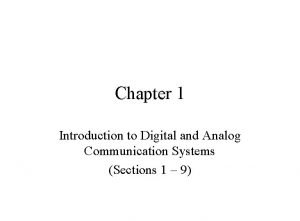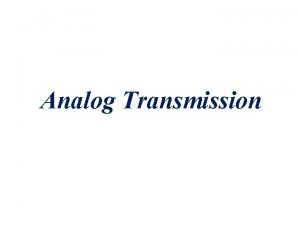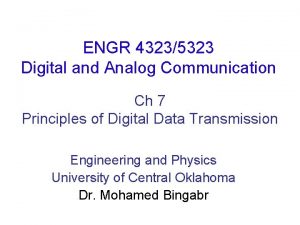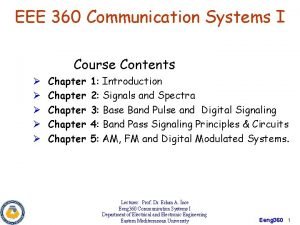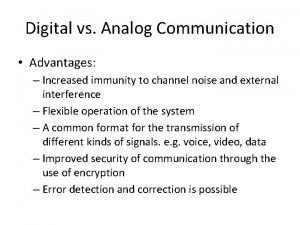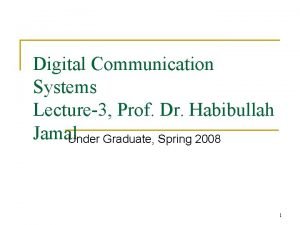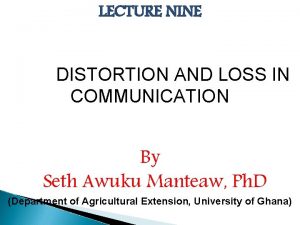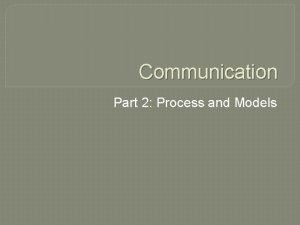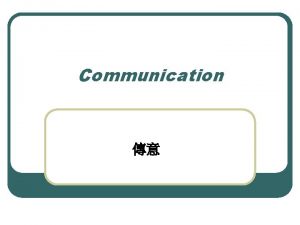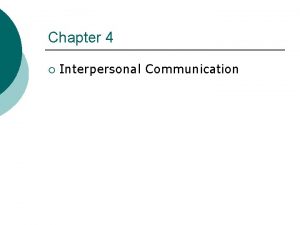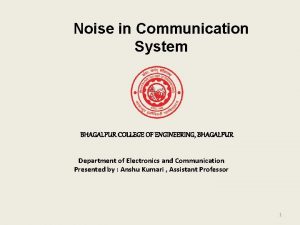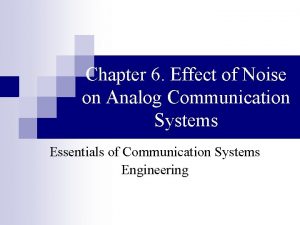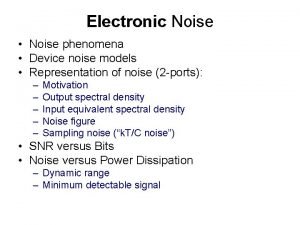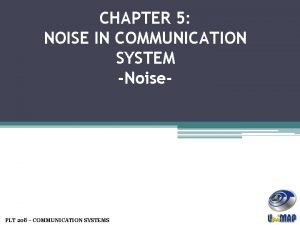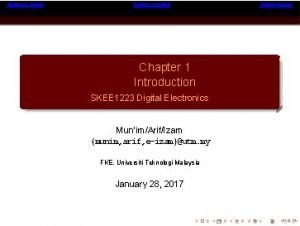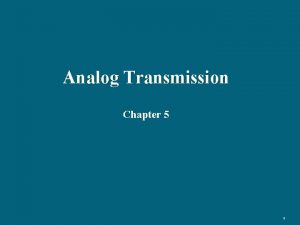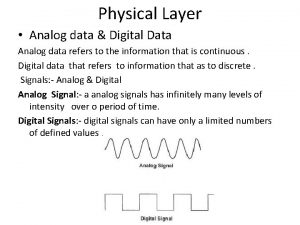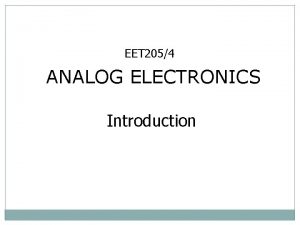Chapter 6 Effect of Noise on Analog Communication





















- Slides: 21

Chapter 6. Effect of Noise on Analog Communication Systems Essentials of Communication Systems Engineering

Introduction n n Angle modulation systems and FM can provide a high degree of noise immunity This noise immunity is obtained at the price of sacrificing channel bandwidth Bandwidth requirements of angle modulation systems are considerably higher than that of amplitude modulation systems This chapter deals with the followings: Effect of noise on amplitude modulation systems ¨ Effect of noise on angle modulation systems ¨ Carrier-phase estimation using a phase-locked loop (PLL) ¨ Analyze the effects of transmission loss and noise on analog communication systems ¨ 2

EFFECT OF NOISE ON AMPLITUDEMODULATION SYSTEMS n n Effect of Noise on a Baseband System Effect of Noise on DSB-SC AM Effect of Noise on SSB-AM Effect of Noise on Conventional AM 3

Effect of Noise on a Baseband System n n n Since baseband systems serve as a basis for comparison of various modulation systems, we begin with a noise analysis of a baseband system. In this case, there is no carrier demodulation to be performed. The receiver consists only of an ideal lowpass filter with the bandwidth W. The noise power at the output of the receiver, for a white noise input, is If we denote the received power by PR, the baseband SNR is given by (6. 1. 2) 4

White process (Section 5. 3. 2) n n n White process is processes in which all frequency components appear with equal power, i. e. , the power spectral density (PSD), Sx(f), is a constant for all frequencies. the PSD of thermal noise, Sn(f), is usually given as (where k is Boltzrnann's constant and T is the temperature) The value k. T is usually denoted by N 0, Then 5

Effect of Noise on DSB-SC AM n Transmitted signal : n The received signal at the output of the receiver noiselimiting filter : Sum of this signal and filtered noise n Recall from Section 5. 3. 3 and 2. 7 that a filtered noise process can be expressed in terms of its in-phase and quadrature components as (where nc(t) is in-phase component and ns(t) is quadrature component) 6

Effect of Noise on DSB-SC AM n Received signal (Adding the filtered noise to the modulated signal) n Demodulate the received signal by first multiplying r(t) by a locally generated sinusoid cos(2 fct + ), where is the phase of the sinusoid. n Then passing the product signal through an ideal lowpass filter having a bandwidth W. 7

Effect of Noise on DSB-SC AM n The multiplication of r(t) with cos(2 fct + ) yields n The lowpass filter rejects the double frequency components and passes only the lowpass components. 8

Effect of Noise on DSB-SC AM n n In Chapter 3, the effect of a phase difference between the received carrier and a locally generated carrier at the receiver is a drop equal to cos 2( ) in the received signal power. Phase-locked loop (Section 6. 4) The effect of a phase-locked loop is to generate phase of the received carrier at the receiver. ¨ If a phase-locked loop is employed, then = 0 and the demodulator is called a coherent or synchronous demodulator. ¨ n In our analysis in this section, we assume that we are employing a coherent demodulator. ¨ With this assumption, we assume that = 0 9

Effect of Noise on DSB-SC AM n Therefore, at the receiver output, the message signal and the noise components are additive and we are able to define a meaningful SNR. The message signal power is given by ¨ power PM is the content of the message signal n The noise power is given by n The power content of n(t) can be found by noting that it is the result of passing nw(t) through a filter with bandwidth Bc. 10

Effect of Noise on DSB-SC AM n Therefore, the power spectral density of n(t) is given by n The noise power is n Now we can find the output SNR as n In this case, the received signal power, given by Eq. (3. 2. 2), is PR = Ac 2 PM /2. 11

Effect of Noise on DSB-SC AM n The output SNR for DSB-SC AM may be expressed as ¨ n which is identical to baseband SNR which is given by Equation (6. 1. 2). In DSB-SC AM, the output SNR is the same as the SNR for a baseband system DSB-SC AM does not provide any SNR improvement over a simple baseband communication system 12

Effect of Noise on SSB AM n SSB modulated signal : n Input to the demodulator n Assumption : Demodulation with an ideal phase reference. Hence, the output of the lowpass filter is the in-phase component (with a coefficient of ½) of the preceding signal. n 13

Effect of Noise on SSB AM n Parallel to our discussion of DSB, we have n The signal-to-noise ratio in an SSB system is equivalent to that of a DSB system. 14

Effect of Noise on Conventional AM n DSB AM signal : n Received signal at the input to the demodulator n ¨ a is the modulation index ¨ mn(t) is normalized so that its minimum value is -1 ¨ If a synchronous demodulator is employed, the situation is basically similar to the DSB case, except that we have 1 + amn(t) instead of m(t). After mixing and lowpass filtering 15

Effect of Noise on Conventional AM n Received signal power ¨ n Assumed that the message process is zero mean. Now we can derive the output SNR as ¨ denotes the modulation efficiency ¨ Since , the SNR in conventional AM is always smaller than the SNR in a baseband system. 16

Effect of Noise on Conventional AM In practical applications, the modulation index a is in the range of 0. 8 -0. 9. ¨ Power content of the normalized message process depends on the message source. ¨ Speech signals : Large dynamic range, PM is about 0. 1. ¨ n The overall loss in SNR, when compared to a baseband system, is a factor of 0. 075 or equivalent to a loss of 11 d. B. The reason for this loss is that a large part of the transmitter power is used to send the carrier component of the modulated signal and not the desired signal. To analyze the envelope-detector performance in the presence of noise, we must use certain approximations. ¨ This is a result of the nonlinear structure of an envelope detector, which makes an exact analysis difficult. 17

Effect of Noise on Conventional AM ¨ In this case, the demodulator detects the envelope of the received signal and the noise process. ¨ The input to the envelope detector is ¨ Therefore, the envelope of r ( t ) is given by ¨ Now we assume that the signal component in r ( t ) is much stronger than the noise component. Then ¨ Therefore, we have a high probability that 18

Effect of Noise on Conventional AM n After removing the DC component, we obtain ¨ which n is basically the same as y(t) for the synchronous demodulation without the ½ coefficient. ¨ This coefficient, of course, has no effect on the final SNR. ¨ So we conclude that, under the assumption of high SNR at the receiver input, the performance of synchronous and envelope demodulators is the same. However, if the preceding assumption is not true, that is, if we assume that, at the receiver input, the noise power is much stronger than the signal power, Then 19

Effect of Noise on Conventional AM (a) : is small compared with the other components ¨ (b) : ; the envelope of the noise process ¨ Use the approximation , where ¨ 20

Effect of Noise on Conventional AM n Then ¨ We observe that, at the demodulator output, the signal and the noise components are no longer additive. ¨ In fact, the signal component is multiplied by noise and is no longer distinguishable. ¨ In this case, no meaningful SNR can be defined. ¨ We say that this system is operating below the threshold. ¨ The subject of threshold and its effect on the performance of a communication system will be covered in more detail when we discuss the noise performance in angle modulation. 21
 White noise in analog communication
White noise in analog communication Noise
Noise Fidelity of receiver
Fidelity of receiver Analog communication system
Analog communication system Analog vs digital communication systems
Analog vs digital communication systems Digital to analog conversion in data communication
Digital to analog conversion in data communication Block diagram of analog communication system
Block diagram of analog communication system Analog communication
Analog communication Switching modulator
Switching modulator Analog communication
Analog communication Linear communication and interactive model
Linear communication and interactive model Psychological noise.
Psychological noise. Process of communication
Process of communication Psychological noise
Psychological noise Semantic noise definition
Semantic noise definition Psychological noise in communication
Psychological noise in communication Psychological noise in communication
Psychological noise in communication Psychological noise in communication
Psychological noise in communication Noise in interpersonal communication
Noise in interpersonal communication Psychological noise.
Psychological noise. Noise is added to a signal in a communication system *
Noise is added to a signal in a communication system * Semantic noise in communication
Semantic noise in communication
